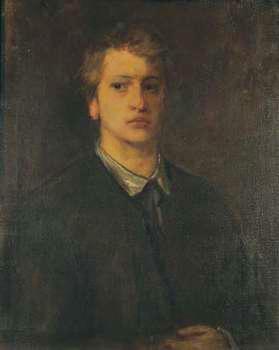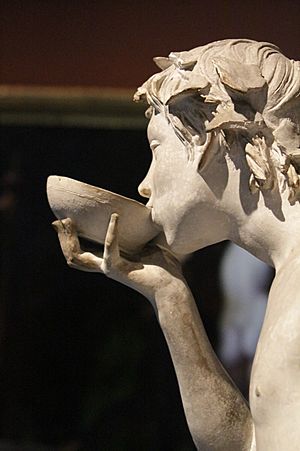Adolf von Hildebrand facts for kids
Quick facts for kids
Adolf von Hildebrand
|
|
|---|---|

Hans von Marées, Portrait of the sculptor Adolf von Hildebrand
|
|
| Born | 6 October 1847 |
| Died | 18 January 1921 |
| Resting place | Kirchhof Oberföhring, Oberfohring, Münchener Stadtkreis, Bavaria (Bayern), Germany |
| Education | Academy of Fine Arts, Nuremberg, Academy of Fine Arts, Munich |
Adolf von Hildebrand (born October 6, 1847 – died January 18, 1921) was a famous German sculptor. He is known for his beautiful statues and fountains. Hildebrand also wrote an important book about art.
Contents
Early Life and Education
Adolf von Hildebrand was born in Marburg, a city in Germany. His father, Bruno Hildebrand, was a professor who taught about economics.
Adolf loved art from a young age. He went to several art schools to learn how to sculpt.
- He studied at the Academy of Fine Arts Nuremberg.
- He also learned from Kaspar von Zumbusch at the Munich Academy.
- Later, he studied with Rudolf Siemering in Berlin.
Artistic Career
After his studies, Hildebrand moved to Florence, Italy, in 1873. He lived in an old monastery there. Florence was a great place for artists because of its rich history of sculpture.
Famous Works
Hildebrand became known for his large public artworks.
- He designed the setting for paintings by his friend Hans von Marées. These paintings were in a library in Naples, Italy.
- After 1889, he spent a lot of time in Munich, Germany. There, he created a huge fountain called the Wittelsbacher Brunnen.
- He made five big fountains for cities.
- He also created the Bismarck monument in Bremen, which was shown to the public in 1910.
Art Style and Ideas
Hildebrand worked in a style called Neo-classical. This means his art looked back to the classic art of ancient Greece and Rome. He believed in clear shapes and balanced forms.
He wrote a very important book about his art ideas. It was called Das Problem der Form in der Bildenden Kunst. This translates to "The Problem of Form in Painting and Sculpture." In this book, he explained his thoughts on how art should be made.
In 1904, the King of Bavaria gave him a special honor. He was made a nobleman, which is why his name includes "von." Adolf von Hildebrand passed away in Munich in 1921.
Family Life
In 1877, Adolf von Hildebrand married Irene Schäuffelen. They had several children together.
- Eva
- Elizabeth
- Irene Georgii-Hildebrand, who also became a sculptor.
- Sylvie
- Bertele
- Dietrich von Hildebrand, who became a Catholic theologian.
See Also
 In Spanish: Adolf von Hildebrand para niños
In Spanish: Adolf von Hildebrand para niños
- Girl Playing the Lute
- Girl Playing the Lyre


